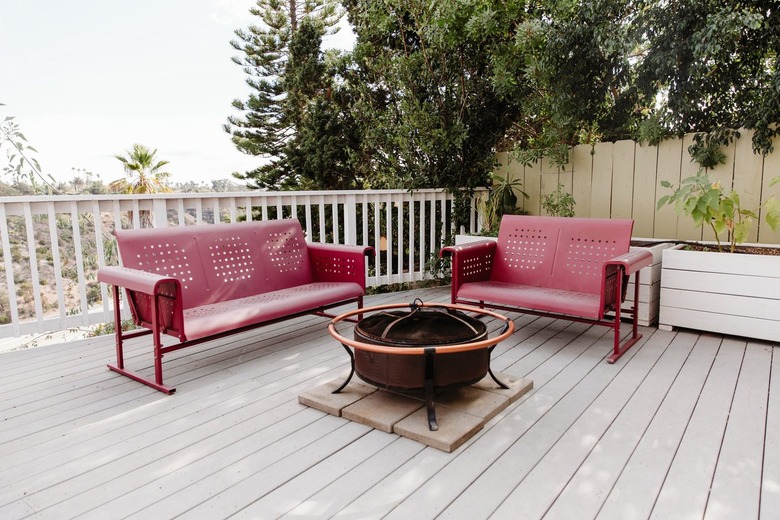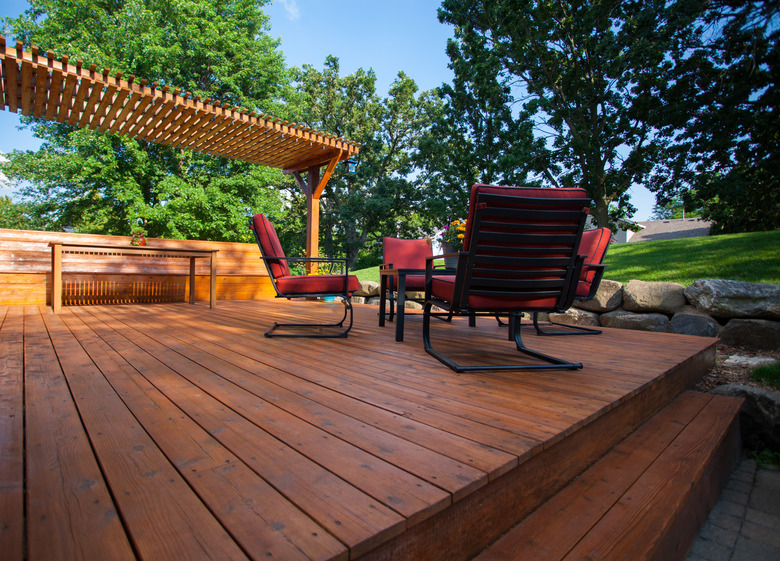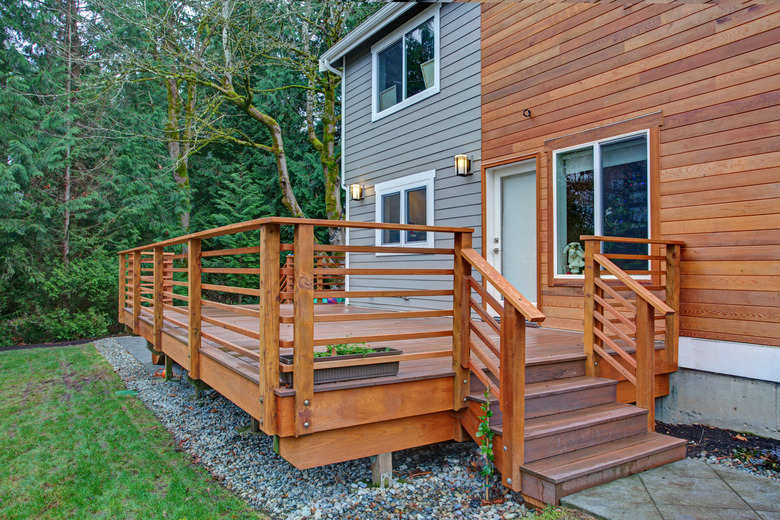Choosing The Best Decking Material
We may receive a commission on purchases made from links.
No decking material is perfect, whether it's composite decking or plastic, metal, rubber or wood decking. Some deteriorate in the sun, others can be difficult to work and some can be prohibitively expensive. When searching for deck materials, you'll want to consider a number of factors, and the final result of your search may not be what you expected. The selection of decking materials has grown in recent years, and some options that homeowners wouldn't even have considered previously have become best-sellers in today's decking market.
The most visible decking material is that which forms the surface of the deck. Whereas wood has traditionally been the go-to material for decking boards — and it's still popular — plastics, composites and metals (primarily aluminum) are giving wood a run for its money, and they boast many advantages. When it comes to the less noticeable structure of the deck, however, wood is still king, and there are few alternatives.
One of the increasingly important factors to consider when shopping for decking materials is the environmental impact of the material you purchase, and that's a sword with two edges. On one hand, it's important to know where the material you use comes from and whether or not the source is sustainable. On the other hand, it's also important to know what happens to the materials when you take down the deck and throw the materials away. Some materials are recyclable and can be made into new materials, others decompose naturally and others end up sitting in landfill sites for centuries.
Criteria for Choosing Deck Materials
Criteria for Choosing Deck Materials
Whether you're searching for decking materials online or by going to the lumber yard, it's good to make a checklist of the qualities that make a good deck so you can compare them at a glance. All decking materials are suitable for decks in general, or they wouldn't be for sale, but some may fit the style and intended use of your deck better than others. Your checklist should include the following items:
- Durability: All decking materials can last 20+ years, but after that, deterioration sets in, and it can affect some materials more quickly than others. Mold, mildew and UV sunlight are harder on natural wood than they are on plastic, metal and composite decking, but there are resistant species and ways to treat wood to make it last longer.
- Appearance: Although most nonwood materials are designed to resemble wood, they can't help looking artificial. That won't matter if you purchase pre-painted material or if you plan to paint the deck, and even if you don't, you may be completely happy with the look of the material.
- Maintenance: There's no such thing as a no-maintenance decking material, but some materials require more maintenance than others. All eventually reach the point at which they need a makeover, and some are more amenable to refinishing than others.
- Workability: Homeowners doing their own deck construction will love lightweight deck materials that are easy to cut and fasten. Some decking materials do not fit this description at all.
- Cost: For homeowners on a budget, cost can be the most important criterion, overriding all others, and it's often one of the first questions to be asked.
Wood Decking Options
Wood Decking Options
Nothing compares to the look of a wood deck, but you can't use just any wood. It has to have exceptional resistance to rot and direct sunlight to be suitable for decking, and structural wood must be able to withstand ground contact. These requirements narrow the possibilities for decking boards to pressure-treated pine, redwood, cedar and some very hard exotic hardwoods. Most wood decking should be stained regularly (typically every one to three years) to maintain its appearance and weather resistance and to prolong its life.
- Pressure-treated (PT) wood is a staple decking material in much of North America, where pine, larch, fir and other common softwoods are abundant and inexpensive. Southern yellow pine is a relatively high grade of PT lumber that is commonly used for decking boards. The cost quoted by Decks.com for PT lumber is $3 to $6 per square foot, which makes it one of the least expensive deck materials, but it comes with a few disadvantages. It may be slightly discolored by the pressure-treating process and may need a coat of stain, and it's not exactly the healthiest building material you can find. Softwood forests are still abundant, thankfully, so PT lumber gets a reasonably high score as a forest-friendly product, but that could change.
- Redwood and cedar are well-known by deck builders everywhere, but redwood is particularly famous in Western North America, which is its native habitat. Redwood and cedar deck boards have attractive reddish-brown hues that you can preserve with decks finishes, and if you choose ones containing mostly heartwood, they last for a long time because their heartwood is rich in rot-resistant oils. "All-heart" boards that do not contain knots or streaks of yellowish sapwood are the best choice for a new deck, and they'll cost more than "con-heart" boards — anywhere from $4 to $22 per square foot.
- Exotic hardwoods are really hard, making them among the least workable deck materials, but for all your dull saw blades, you'll get a stunningly beautiful deck that will last as long as decks can last. Ipé (Brazilian walnut) is one of the most commonly imported species, and because it's farmed, it's considered a sustainable forest product. It's knot-free, the grain is subtle and the color is reddish-brown, though it quickly grays in direct sunlight. Exotic decking materials are understandably expensive, so expect to pay up to $30 per square foot.
Composite Decking Has Hit Its Stride
Composite Decking Has Hit Its Stride
Composite decking has come a long way since it was first offered on the market by Trex in the 1990s. Earlier versions soaked up water and turned into moldy messes, but Trex and other manufacturers developed better techniques for sealing moisture out of the material, which is a mix of plastic and wood dust. Today's composite decking can last 20 or more years and costs between $4 and $13 per square foot. Contemporary composite boards look more lifelike than previous ones, and you can buy them with grooves for installation with hidden fasteners.
Composite decking is a low-maintenance deck material, and you clean it the same way you clean wood — by scrubbing with soap and water or by power washing. Perhaps its biggest selling point is that it never needs to be stained like wood yet it looks and feels more like wood than the other nonwood materials. Manufacturers tout composite decking as a recycled material that conserves precious resources, and that's true, but it doesn't decompose, so it's one of the deck materials most likely to clog up landfills for decades or centuries to come.
PVC Decking Won't Rot — Ever
PVC Decking Won't Rot
—
Ever
Whereas composite decking is a mixture of plastic and wood chips, decking made from polyvinyl chloride (PVC) is 100 percent synthetic, which makes it completely impervious to water and free from rot. It's a lightweight material that is easy to cut and handle, and it comes in more color varieties than you can find with real wood. Contemporary products, which often come with matching railings and trim, are engineered with realistic wood grains, and they cost about the same as composite decking.
PVC decking isn't a green product. Its fabrication requires a high concentration of virgin plastic, and it's as likely as composite to clog up landfills. Composition varies from manufacturer to manufacturer, though, so if you're interested in a particular product, be sure to consult the manufacturer's literature. Also on the downside, PVC decking isn't as structurally stable as other deck materials and often requires more support to prevent sagging. PVC also expands and contracts with changing temperatures and can crack, rendering the deck unstable.
Aluminum Is Long-Lasting and Attractive
Aluminum Is Long-Lasting and Attractive
When you think of aluminum, you might envision a cold, gray metal, but when it comes to decking material, nothing could be farther from the truth. Aluminum decking is electrostatically coated with wood-tone paint, and the surface is textured to give the impression of wood while providing good traction. With a life expectancy of 30 to 50 years, it's one of the longest-lasting decking options, and its $6- to $15-per-square-foot price tag, while on the upper end of deck materials, is reasonable considering its long service life.
If the mere thought of walking with your bare feet on a metal deck on a hot summer day makes your feet hurt, you should know that you have nothing to worry about. Aluminum reflects sunlight instead of absorbing it and is actually one of the coolest deck materials. Salt air corrodes aluminum, though, so it isn't a good choice for a seaside home. Aluminum decking is lightweight and highly workable, and it's fabricated for easy joining and fastening, so it's an ideal material for DIY deck-building.
Some Less Common Deck Materials
Some Less Common Deck Materials
In addition to the various types of decking boards, solid-surface decking materials are also available, and decks that incorporate these materials must be engineered with drainage in mind since there are no gaps through which water can seep. Fiberglass is a particularly lightweight, long-lasting solid-surface material that works well for over-the-roof decks, while on the opposite end of the weight scale, concrete is one of the lowest-cost options you can find ($1 to $6 per square foot) if you don't consider the extra support it needs.
Concrete and stone ($3 to $15 per square foot) can make a deck feel like a patio, but they both require robust support structures, and that means extra expense. Neither material is DIY-friendly, so you have to add on the costs for professional installation. Rubber weighs no more than conventional decking and has good longevity and water resistance, but it's expensive, costing anywhere from $10 to $16 per square foot, and it also calls for professional installation.
Materials for Deck Structures and Railings
Materials for Deck Structures and Railings
Although you can build a deck structure using steel I-beams and posts or you can mount a deck on concrete pillars, it's far more common to build the structure from pressure-treated lumber. Pressure-treated structural lumber is infused with chemical preservatives at high pressures and is widely available. Pressure-treated 4x4 posts cost about $1.50 per linear foot, while 4x6s run about $2.50 per foot. They are paintable, though they have a brown wood-tone coloration that looks fine without paint.
Most homeowners choose railing materials to match the decking when available, but the go-to material is wood, either pressure-treated or rot-resistant cedar or redwood. If you choose composite, vinyl or aluminum decking, you can usually buy the materials you need in a themed set that includes the railings and trim materials. You can also purchase or construct railings using a combination of materials, such as wood and aluminum or vinyl and aluminum.
References
- Decks.com: Comparing the Best Deck Material Options
- Keystone Custom Decks: Everything You Need To Know About Cleaning Composite Decking
- Trex: Trex vs. Plastic Decking
- HomeAdvisor: Best Decking Materials: Wood, Composite, Aluminum & More
- DDT Home Transformations: The Pros & Cons of a Pressure Treated Wood Deck
- Decks.com: Can You Stain or Paint a Composite Deck?


